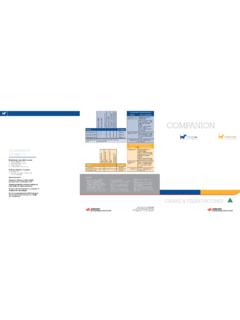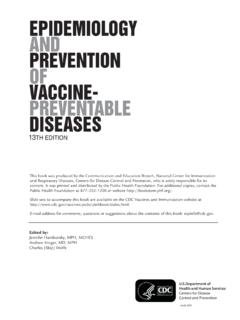Transcription of Foot and mouth disease vaccination and post-vaccination ...
1 Foot and mouth disease vaccination and post - vaccination monitoring Guidelines Editors Samia Metwally Susanne M nstermann Sus Authors Giancarlo Ferrari David Paton Sergio Duffy Chris Bartels Theo Knight-Jones Foot and mouth disease vaccination and post - vaccination monitoring Guidelines Editors Samia Metwally & Susanne M nstermann Authors Giancarlo Ferrari, David Paton, Sergio Duffy, Chris Bartels & Theo Knight-Jones Published by The Food and Agriculture Organization of the United Nations and the World Organisation for Animal Health The designations employed and the presentation of material in this information product do not imply the expression of any opinion whatsoever on the part of the Food and Agriculture Organization of the United Nations (FAO), or of the World Organisation for Animal Health (OIE) concerning the legal or development status of any country, territory, city or area or of its authorities, or concerning the delimitation of its frontiers or boundaries.
2 The mention of speci c companies or products of manufacturers, whether or not these have been patented, does not imply that these have been endorsed or recommended by FAO or OIE in preference to others of a similar nature that are not mentioned. The views expressed in this information product are those of the author(s) and do not necessarily re ect the views or policies of FAO or OIE. FAO encourages the use, reproduction and dissemination of material in this information product. Except where otherwise indicated, material may be copied, downloaded and printed for private study, research and teaching purposes, or for use in non-commercial products or services, provided that appropriate acknowledgement of FAO as the source and copyright holder is given and that FAO's endorsement of users' views, products or services is not implied in any way.
3 All requests for translation and adaptation rights, and for resale and other commercial use rights should be made via or addressed to FAO information products are available on the FAO website ( ) and can be purchased through FAO and OIE, December 2016. FAO ISBN: 978-92-5-109349-8. OIE ISBN: 978-92-95108-25-7. iii Foreword The past decade has been an exciting period for foot and mouth disease (FMD) control and elimination efforts. The progressive control pathway for FMD (PCP-FMD) was developed to provide a novel stepwise methodology for a risk management and cost effective approach to FMD control. The PCP-FMD contributed signi cantly to the FAO-OIE Global Control Strategy (2012), whereby it represented the backbone for its implementation. The Food and Agriculture Organization of the United Nations (FAO) and the World Organisation for Animal Health (OIE) continue to encourage and support their membership in making FMD.
4 Control a feasible option to reduce its impact on food security and safe trade and to contribute to improved livelihoods. Foot and mouth disease remains endemic in many countries in most parts of Asia, Africa and the Middle East. Any FMD outbreak can have potentially devastating impacts on farmers with adverse effects on livestock assets, production income, available nutrition and consumption. Vaccine is one of the main tools proven to better manage or eliminate the disease when properly applied and with desirable quality and composition. It is imperative that up-to-date information on circulating virus strains in any geographical location be known for selection of appropriate vaccine strains. Typically, the cost of vaccine and vaccination represents over 90% of the total expense of FMD control so that it is essential to plan and evaluate vaccine and vaccination effectiveness to convince decision makers, including the most important farmers to maintain rigorous vaccination efforts.
5 The guidelines herein are developed under the auspices of FAO and OIE to advise on the principles of FMD vaccine/. vaccination monitoring and best practices for vaccine application with the focus on how to evaluate and ensure the success of the vaccination programmes. These guidelines are presented from experts'. viewpoint to determine the vaccine effectiveness against the circulating FMD viruses, which directly affect multiple cloven-hoofed species and can indirectly cripple local and global commerce. These guidelines are designed to guide and assess national or sub-national vaccination programmes at various stages of PCP-FMD; and can be equally helpful for regaining FMD free status following the incursion of FMD virus in previously free countries or those where vaccination is to be discontinued, as given in the OIE Terrestrial Animal Health Code.
6 The importance of effective performance of Veterinary Services to implement FMD control programmes, particularly vaccination , is highlighted in the guidelines. Given that most readers and users may have a broad background in disease management and may not necessarily be FMD specialists, the contributors have sought to provide a balance of scienti c background, methodology and practical examples. We wish to thank the editors and authors for developing these guidelines and the reviewers from many countries representing Asia, Africa and South America, and vaccine producers as well as selected FMD. specialists, including those from OIE and FAO reference centres, for their valuable contributions. Dr Juan Lubroth Dr Monique loit Chief, Animal Health Service Director General FAO OIE. Foot and mouth disease vaccination and post - vaccination monitoring .
7 Guidelines CONTENTS. FOREWORD iii .. EXECUTIVE SUMMARY.. 3. ACKNOWLEDGEMENT .. 4. INTRODUCTION .. 5. CHAPTER 1 - VACCINE ATTRIBUTES 9. Introduction .. 11. Vaccine types .. 11. Vaccine matching and criteria for selection of vaccine strains.. 11. Vaccine quality .. 12. Requirements during manufacturing process .. 12. Requirements for vaccine registration process.. 13. Considerations when purchasing vaccine .. 13. Vaccine purchase through a tender procedure .. 13. Vaccine supply to the tenderer .. 14. Checklist for vaccine selection .. 14. CHAPTER 2 - VACCINE PROGRAMME, DELIVERY, SCHEDULE AND COVERAGE 15. Introduction .. 17. Objectives of a vaccination programme .. 17. Vaccine delivery .. 18. Packaging .. 18. Cold chain and logistics management .. 18. vaccination schedule .. 18. Vaccine coverage .. 19. Checklist for implementing vaccination .
8 20. CHAPTER 3 - EVALUATION OF THE IMMUNE RESPONSE 23. Introduction .. 25. Use of serological tests for post - vaccination monitoring .. 27. Antibody responses to structural proteins .. 27. Correlation between structural protein antibody responses and protection .. 28. Antibody responses to non-structural proteins.. 28. 2 Foot and mouth disease vaccination and post - vaccination monitoring . Guidelines Small-scale trial for the evaluation of vaccine quality .. 28. vaccination protocol and blood sampling .. 29. Antibody testing .. 29. Interpretation of the results .. 29. Evaluation of immune responses in vaccinated animals under eld conditions .. 31. post - vaccination monitoring to assess immunity at population level .. 32. post - vaccination monitoring to assess population immunity at individual animal level.
9 35. post - vaccination monitoring to assess population immunity at herd level.. 36. Checklist for post - vaccination monitoring of immunity.. 37. CHAPTER 4 - monitoring THE IMPACT OF vaccination AND OTHER CONTROL MEASURES 39. Introduction .. 41. Vaccine ef cacy and effectiveness .. 41. Investigating outbreaks in vaccinated animals .. 42. Effectiveness of a foot and mouth disease control programme .. 43. monitoring .. 44. Status at the start of implementation .. 44. Expected outcomes .. 45. REFERENCES 47. ANNEXES 51. ANNEX 1 monitoring vaccine coverage .. 53. ANNEX 2 Statistical methods for designing eld surveys of population immunity .. 59. ANNEX 3 Strengthening Veterinary Services .. 71. ANNEX 4 Vaccine effectiveness.. 73. 3. Executive summary Foot and mouth disease (FMD) control and/or eradication measures have been in existence for many years in different regions, supported by an of cial World Organisation for Animal Health (OIE) system for recognition of national control programmes and of country status in order to manage the trade risks for reintroduction of FMD.
10 A global FMD control strategy was announced by the Food and Agriculture Organization of the United Nations (FAO) and OIE in 2012, incorporating a progressive control pathway for FMD (PCP-FMD) that elaborates principles for the application of control measures in a step-wise manner. The OIE Performance of Veterinary Services tool helps countries to monitor the structures essential for implementation of their programmes. vaccination is an important component of programmes that seek to reduce the impacts of FMD and to block circulation of the causative virus in order to establish and maintain disease freedom. The choice and successful implementation of the appropriate vaccine and vaccination regimens are affected by many dynamic factors, including: (i) the diversity of the viruses to be controlled (ii) the performance characteristics and instability of vaccines (iii) the range of susceptible animal species and husbandry systems (iv) the purposes of vaccination (v) the short-lived nature of vaccine-induced immunity, and (vi) the design and application of vaccination programmes.
















